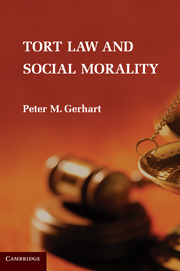Book contents
- Frontmatter
- Contents
- Preface
- Acknowledgments
- PART I OTHER-REGARDING BEHAVIOR
- PART II THE NORMATIVE JUSTIFICATION
- PART III THE THEORY APPLIED
- 6 Social Cohesion and Autonomy: The Justificational Boundary of Duty
- 7 Social Cohesion and Moral Agency: The Justification for Proximate Cause
- 8 Social Cohesion and Strict Liability
- 9 Using Another's Property
- 10 Product Liability: Social Cohesion and Agency Relationships
- 11 Customer-Centered Enterprise Liability
- 12 Social Cohesion and Knowledge: The Intentional Torts
- PART IV SUMMARY AND IMPLICATIONS
- Index
12 - Social Cohesion and Knowledge: The Intentional Torts
Published online by Cambridge University Press: 04 August 2010
- Frontmatter
- Contents
- Preface
- Acknowledgments
- PART I OTHER-REGARDING BEHAVIOR
- PART II THE NORMATIVE JUSTIFICATION
- PART III THE THEORY APPLIED
- 6 Social Cohesion and Autonomy: The Justificational Boundary of Duty
- 7 Social Cohesion and Moral Agency: The Justification for Proximate Cause
- 8 Social Cohesion and Strict Liability
- 9 Using Another's Property
- 10 Product Liability: Social Cohesion and Agency Relationships
- 11 Customer-Centered Enterprise Liability
- 12 Social Cohesion and Knowledge: The Intentional Torts
- PART IV SUMMARY AND IMPLICATIONS
- Index
Summary
It is understood that intentional torts chart the boundary between socially acceptable and antisocial behavior – between, for example, offensive and inoffensive contact or between reasonable and unreasonable invasion of another's emotional well-being. The connection with social cohesion is clear. Yet it is also common to think of intentional torts as a different class of torts from those encompassed by the negligence regime. That division is understandable if we consider the paradigmatic case of the person who knowingly and maliciously hits another. The fault in that kind of a case seems to be a far cry from the fault in the case of the person who inadvertently fails to check the blind spot in the mirror when changing lanes.
Yet these two tort regimes are joined together by the theory of other-regarding behavior, for each represents a situation in which one person has failed to appropriately consider the well-being of another. Moreover, the border between negligence torts and intentional torts is far thinner than is normally supposed. For example, the cases discussed in the last chapter are not usually thought of as implicating intentional torts, but they do. In those cases, the defendant knew that harm would occur and that knowledge was one of the reasons they were responsible for reacting reasonably to the harm.
In this chapter, I explore our understanding of the relationship between negligence torts and intentional torts by showing how intentional torts embody the theory of other-regarding behavior developed in this book.
- Type
- Chapter
- Information
- Tort Law and Social Morality , pp. 226 - 234Publisher: Cambridge University PressPrint publication year: 2010



